Ray Givan’s Fig Page – Green and Yellow Fig Varieties

Several years ago I met fig expert Ray Givan and featured him on the “The Georgia Gardener” TV show. At that time he had a small website describing the figs he had grown. It was an invaluable resource to me. In the intervening years, Ray has gotten divorced and has moved around, leaving his website un-maintained. I found a copy of his site and have posted it below.
If you know where Ray can be found, please tell him to contact me.
Green and Yellow Fig Varieties
Adriatic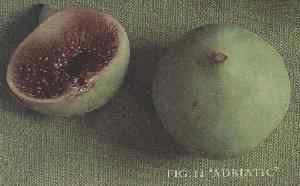
A medium greenish-yellow fig with light strawberry pulp and good flavor. Turbinate with small or no neck. Leaf: base is subcordate to truncate; usually 5-lobed; middle lobe spatulate. Very subject to mosaic. Light breba crop. Well-adapted in Northern California and the Northwest. Disappointing in the South as it leafs out early and is susceptible to damage from late freezes. Good all-purpose fig. Synonyms: Chico, Grosse Verte, Nebian, Strawberry, Verdone, White Adriatic.
Alma
A small to medium golden-brown fig with amber pulp. Pyriform without neck. Leaf: base decurrent, unlobed to 3 lobes. Sweet and delicate flavor. Bred by Texas A & M and released in 1975. Main crop only. Well adapted in the Southeast. highly resistant to fruit rots. Wood is very hardy, but the fruit buds are damaged by hard freezes. Seems to thrive in cooler climates. An interspecies cross between F. palmata and F. carica. Has a tendency to weediness so it needs careful pruning to be productive. Synonym: Fall Gold.
Blanche
See Marseilles.
Brunswick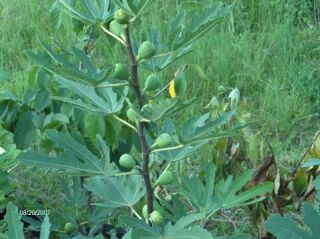
A medium to large fig with bronzy-yellow skin and rich flavor. Oblique- turbinate. Leaf: base calcarate; lobes, lineate. Well-adapted in the Southwest and drier areas of the South. The fruit is ruined by excessive rain. Breba and main crop. Hardy. (Condit accepts Brunswick as the correct name, but see the discussion of this name in the Introduction.) Synonyms: Dalmatian, Madonna, Magnolia.
Conadria
A medium to large yellow-green fig with light strawberry pulp and rich flavor, bred by Ira Condit and released in 1957. Pyriform. Leaf: base cordate; 5 lobes, middle lobe spatulate. Well-adapted in California and the Southeast. Fairly hardy. Worth a trial in northerly areas. Synonyms: Adriatic Hybrid, Verdone Hybrid.
Deanna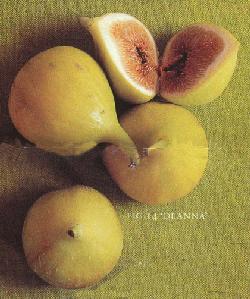
A medium to large, golden yellow fig with strawberry pulp. From Condit’s breeding program. I acquired this one in 1997 and failed to keep notes on its leaf shape. It has not fruited for me so I could not record the shape and character of the fruit. A. J. Bullard of North Carolina says it is an excellent fig. Apparently hardy. No synonyms.
Excel
A medium, yellow fig with amber pulp, selected and released by Bill Storey and released in 1975. Oblate to spherical without neck. Leaf: base truncate to subcordate; 3 lobes; shallow sinuses. Well-adapted in California. Early trials in the Southeast are very promising. Seems to be both vigorous and hardy. Very sweet and rich, superb in a word. Good all- purpose fig. Synonyms: Dotatto Hybrid, Kadota Hybrid.
Genoa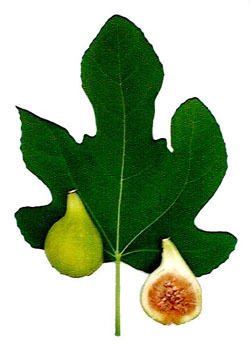
A medium, greenish-yellow fig with amber pulp. Brebas are oblique-pyriform; main crop are turbinate. Does not produce heavy crops of either brebas or main crop figs. Leaf: base broadly subcordate; 3-5 lobes. The flavor is excellent cooler areas of California, but does not hold up in hotter climates where Conadria is a far better choice. Late to ripen—even after the first frosts. Genoa needs annual pruning. Synonyms: White Genoa, White Naples.
Gillette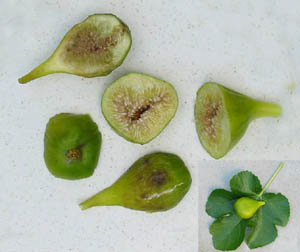
An edible caprifig with small, pale yellow fruit and white pulp. Pyriform with distinct neck. Leaf: base subcordate; mostly 5 lobes. Flavor is fair, but not memorable. Bears a heavy crop of profichi (early fruit), but very few mammoni and mamme. Well-adapted in Northern California and Oregon. Synonyms: Croisic, Cordelia, Pingo de Mel.
Green Ischia
A small, grass-green to greenish-yellow fig with strawberry pulp. Oblate to spherical. Leaf: base broadly sub-cordate to truncate; 3 lobes. Small, fairly well closed eye. Good breba crop. Excellent quality fresh or dried. Adapted to short-summer areas. Tree is small. Hardy. Synonyms: Coeur, Verdale, Verte.
Ischia
A small to medium yellow fig with fair flavor. Oblate to spherical with or without short neck. Leaf: base decurrent. Well-adapted in coastal California. Its quality in the South is poor. Should be trialed in the North. Synonyms: Brockett Hall, Singleton, White Ischia.
Italian Honey Fig
See Lattarula.
Kadota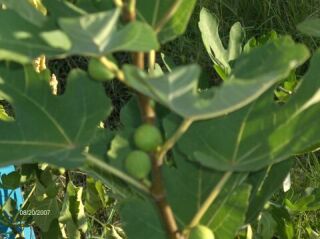
A greenish-white fig, small to medium sized. Pyriform. Leaf: base cordate; 3-5 lobes; shallow sinuses. Vigorous and precocious. Delicious fresh or dried. It is a rich, sweet, all purpose fig and the most common canned fig. Well-adapted in the Southwest and drier areas of the South. Requires heat to develop its best flavor and texture. Fairly hardy. Synonyms: Dattero, Dottato, White Kadota, ad nauseum.
King
A high quality medium, green to greenish-yellow fig with strawberry pulp. Pyriform to oblique. Base sub-cordate; 3-5 lobes; broad, but shallow sinuses. A San Pedro type, it ripens a large breba crop in late May to early June. It sometimes sets main crop figs without pollination in cooler areas, but has never done so for me in the eight years I have had it. Sweet and rich. Originated in California about 1920. Well-adapted in the Northwest. Vigorous and hardy. Best fresh or dried. Synonyms: Desert King, White King.
Lattarula
A medium to large, unidentified, yellowish-green fig widely grown in the Pacific Northwest. Very sweet, good fresh, dried or preserved. Condit does not identify it as a distinct variety and considers it a synonym for Marseilles. I think it is a sport of that variety distinguished by the heavier breba (early) crop. Synonyms: None
Lemon
See Marseilles.
LSU Gold
A large yellow fig blushed with red. Strawberry pulp. (Rumor says it was bred at Louisiana State University.) Leaf: base cordate; 3-5 lobes; latate. I obtained this variety in 1997 and have not yet gotten any fruit from it to date. A. J. Bullard of North Carolina and others say its flavor is outstanding. Has a small eye which leaks honey dew. Said to do well from Florida to North Carolina. Deserves wider trials. No synonyms.
Magnolia
See Brunswick.
Marseilles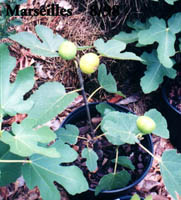
An old, reliable variety. Medium to large greenish-yellow figs with white pulp. Turbinate with or without a short neck. Leaf: base subcordate; 3-5 lobes; margins crenate. It has a small, but open eye and will sour if left too long on the plant. Also subject to splitting, if watered too much when fruit is ripening. Well-adapted in the South where, known as Lemon, it is an heirloom variety. Slow growing. Condit calls it Blanche. (See the discussion of this name in the Introduction.) Hardy. It has a spritely sweet flavor and nutty texture (from the “seeds”). Good fresh, better dried and superb stewed. Synonyms: Bianci, Blanche, Lemon, White Marseilles.
Mary Lane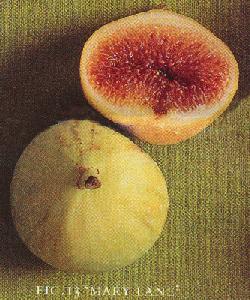
An unidentified, medium, yellow fig said to have originated in California. Leaf: truncate to subcordate; unlobed to 3 lobes; margins coarsely serrate. The fruit is very juicy and nearly seedless. Well-adapted in California and the Northwest. I fruited this variety in 1997 and found it to be as good as A. J. Bullard and other Southern growers say it is. Deserves more trials. Synonyms: Jelly, Seedless.
Monstrueuse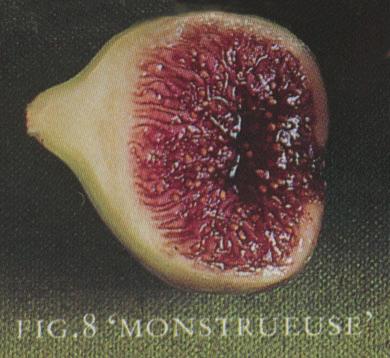
An excellent fig with an unfortunate name. Leaf: cordate, 3 to 5 lobes, upper sinuses shallow, crenate margins. Two crops. Brebas are oblique-pyriform with large, distinct neck, medium to large, green tinged with violet and dark strawberry pulp. Good quality. Main crop figs are slightly smaller, turbinate without neck or with a short one, grass green with light pink pulp. Sweet and rich flavor. Quality and size varies according to local climate. Brebas, for example, are good at Riverside while the main crop is bigger and better on the California coast. I have been looking for this one for five or six years and finally got a couple of plants from some cuttings Don Polensky of San Jose, California sent me in early January 1998. Synonym: Grosse Monstreuse de Lipari.
Panachée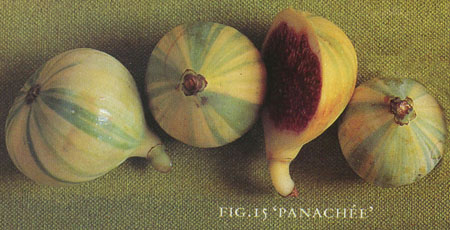
A chimera which produces green fruit with yellow stripes and strawberry pulp. Pyriform with prominent neck. Dry flesh, but sweet. Leaves: not variagated; base calcarate, 3-5 lobes, latate; margins crenate. Condit says Panachée is mediocre to poor, but some aficionados in California say it produces excellent, fresh fruit. No brebas and main crop ripens late. Very poor in south Georgia in 1995-97. My plant may not be the same variety as the one grown in California. I got one plant from some cuttings Don Polensky sent me in January, 1998. I look forward to trialing it here. Synonyms: Panache, Tiger, Variegato.
San Pietro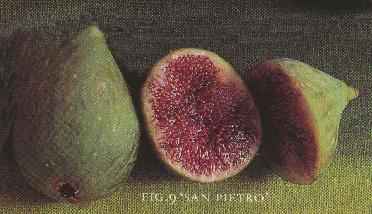
A large light colored fig from the Dalmatian coast of what is now Croatia. Leaf: cordate, variable shape from 3-lobed with shallow sinuses and broad lobes to 5-lobed with deep sinuses and long, narrow lobes, lobes commonly auricled, very shallowly crenate margins. Brebas: light-green, oblique-pyriform with prominent neck, medium eye, dark strawberry pulp. Sweet and rich. Main crop: large, turbinate mostly without neck, yellowish-green, above medium, open eye, light pink pulp. Fairly rich flavor. Condit recommends it only for coastal California. I got two plants from cuttings Don Polensky sent me in January 1998. Now I can trial it here. No synonyms.
Tena
A medium, light green fig with amber to pale pink pulp, Named and released by Bill Storey in 1975. Oblate with small or no neck. Leaf: base truncate to decurrent; 3-5 lobes, lineate; central lobe elongated; margins crenate. Widely-adapted, but likes hot, dry weather. Somewhat hardy. Some say the flavor resembles that of Mission, but it isn’t that good in south Georgia where it is very sweet, but not rich. Good for fresh use and for drying. No synonyms.
White Russian
An unidentified greenish-yellow fig I got from Fred Born who got it from Dorothy Mueleners of Arkansas. The fruit is large, averaging about 2+ ounces. Turbinate with or without short neck. Leaf: base subcordate to cordate; 3-5 lobes, latate; margins crenate. Closely resembles Marseilles, but is said to have a better flavor. I am still trialing it and waiting for a good fruiting season to identify it to my own satisfaction. Possibly a bud mutation.
© Copyright, Ray Givan, 1997, 1998, 1999. Permission to download and print for personal use is granted to viewer. All other rights are reserved.




















